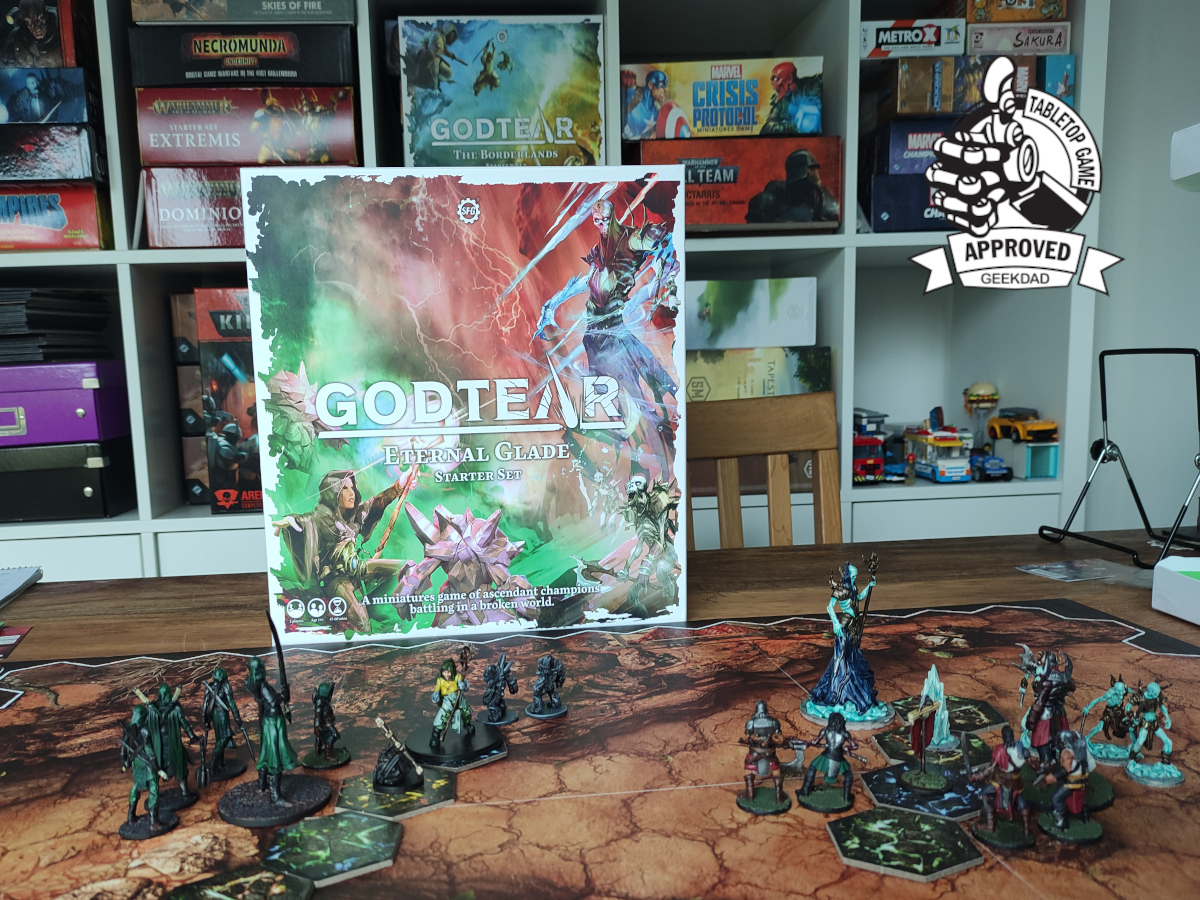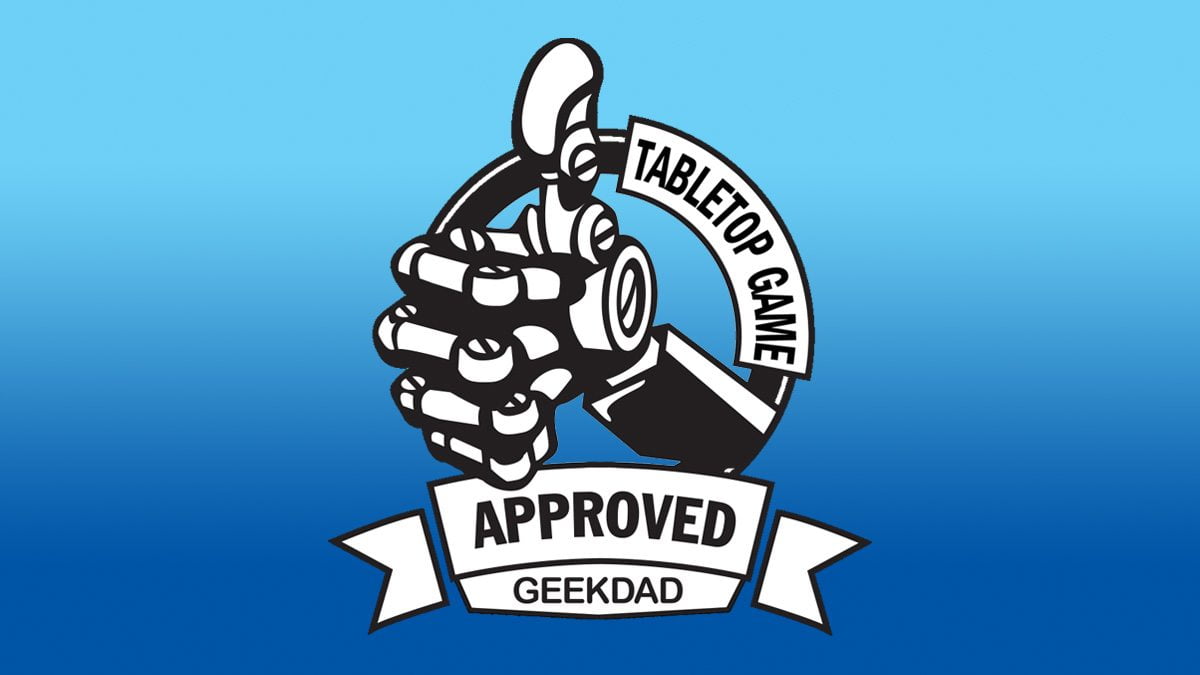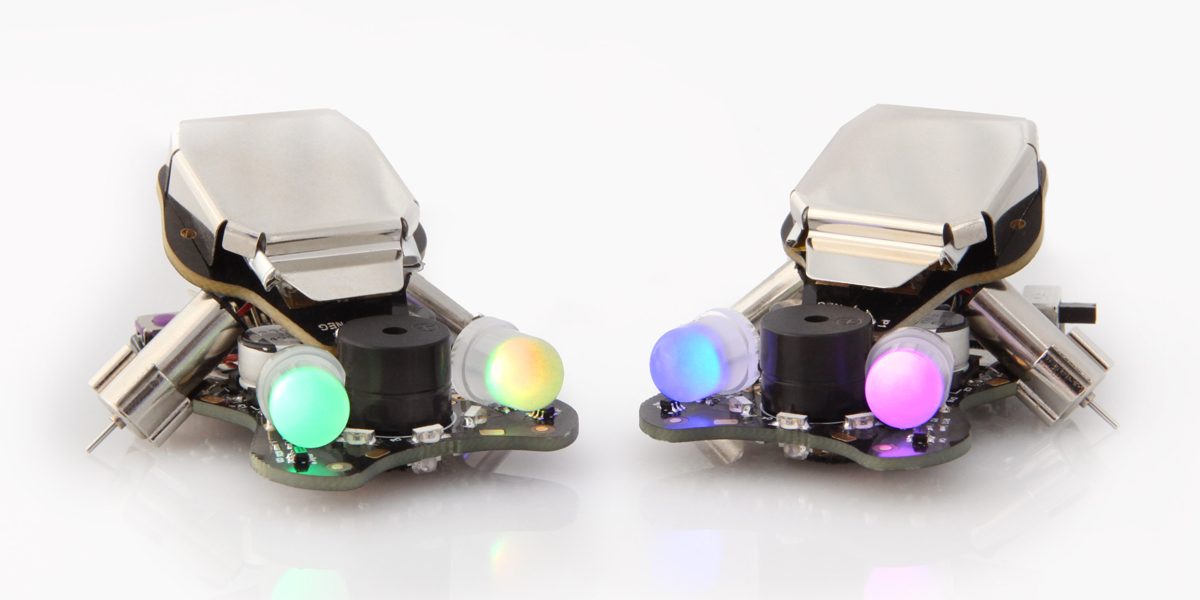Regular GeekDad readers will probably be aware that my main game for the last 4 years has been Warhammer Underworlds. This has changed what I look for in a tabletop miniatures game. With a busy life eating into the time I can spend playing games, something that is easy to set up and quick to play is essential. I’ve also come to love hex-based game design. GodTear from Steamforged Games has all these things, but does it have a strong sense of strategy to go with it? The answer is “Yes!”
I’ve thoroughly enjoyed my games of GodTear, which is why I have awarded it GeekDad Approved.
GodTear: An Overview
Unlike Underworlds, GodTear is not a deckbuilding game. Having become jaded by the constant card chase in Underworlds, I definitely consider this to be a bonus. This being a tabletop miniatures game, there is inevitably a collectible component, but it is less consuming (and consumerist) than in collectible or living card games.
The game pits two groups of warbands against one another. The full game requires 3 warbands vs. 3 warbands. There are currently 2 core sets available. Each core set gives you all the tokens and dice you need to play the game and two warbands. You can play 1v1 games, but this won’t give you the full GodTear experience.
Extra warbands can be purchased to bulk out your core set purchases. You can play with fewer than 6 warbands, but the true tactical complexity comes when there are 6 on the table. Any warband can be played in combination with any other, so when turning up for a game, you just have to choose three from your collection. Part of the challenge, I guess, is working out which bands suit your play style and which ones work well together. Equally, you can just play “rule of cool” and play whatever you like the look of most.
Games take place over 3–5 rounds and have an interesting scoring system that means winning round 3 is of particular importance. A full game with 6 warbands on the table will almost certainly take you over an hour to play, especially when starting. As you become familiar with the decision-making process in the game, this time will come down. It’s worth noting that as miniatures are never taken out of the game, round time does not reduce as the game goes on. There’s often as much tactical decision-making to be made at the death of the game as there is at the start or middle.
What’s in a GodTear Core Box?
A quick look at the Steamforged website tells me that one of the Starter Sets is currently out of stock but the contents are both are essentially the same, except they come with different warbands.
- 12 Preassembled Miniatures. Each warband comes in different colored plastic. GodTear is ready to play out of the box.
- 2 Banners. More miniatures. Every warband in GodTear has its own banner. They’re key to winning the game.
- Double-Sided Battlefield. A good quality cardboard playing area.
- 10 Dice. GodTear uses bespoke dice. They’re D6s but with the numbers 0, 1, and 2 on them.
- 24 Objective Hexes.
- 6 Profile Cards. These cards determine what abilities your fighters have.
- 3 Dashboards. For keeping track of the game state.
- 85 Tokens for tracking the score, hit points, boons, and banes.
- Rules.
Those of you used to Games Workshop miniatures will probably find the GodTear miniatures a little lacking. They are made from a softer plastic and the detail is less defined. If I had one criticism of the game it’s that I don’t find the miniatures that inspiring. Painting is optional and if you don’t have the materials, I think I’d be tempted to keep playing without painting. That said, even with just two or three colors and a heavy drybrush, you really bring the miniatures to life.
The GodTear core set costs $50 and extra warbands are $30. A minium spend therefore for an entire 3 v 3 warband game is $170, but if you just want to field 3 warbands against somebody who already has their own kit minimum spend is $80.
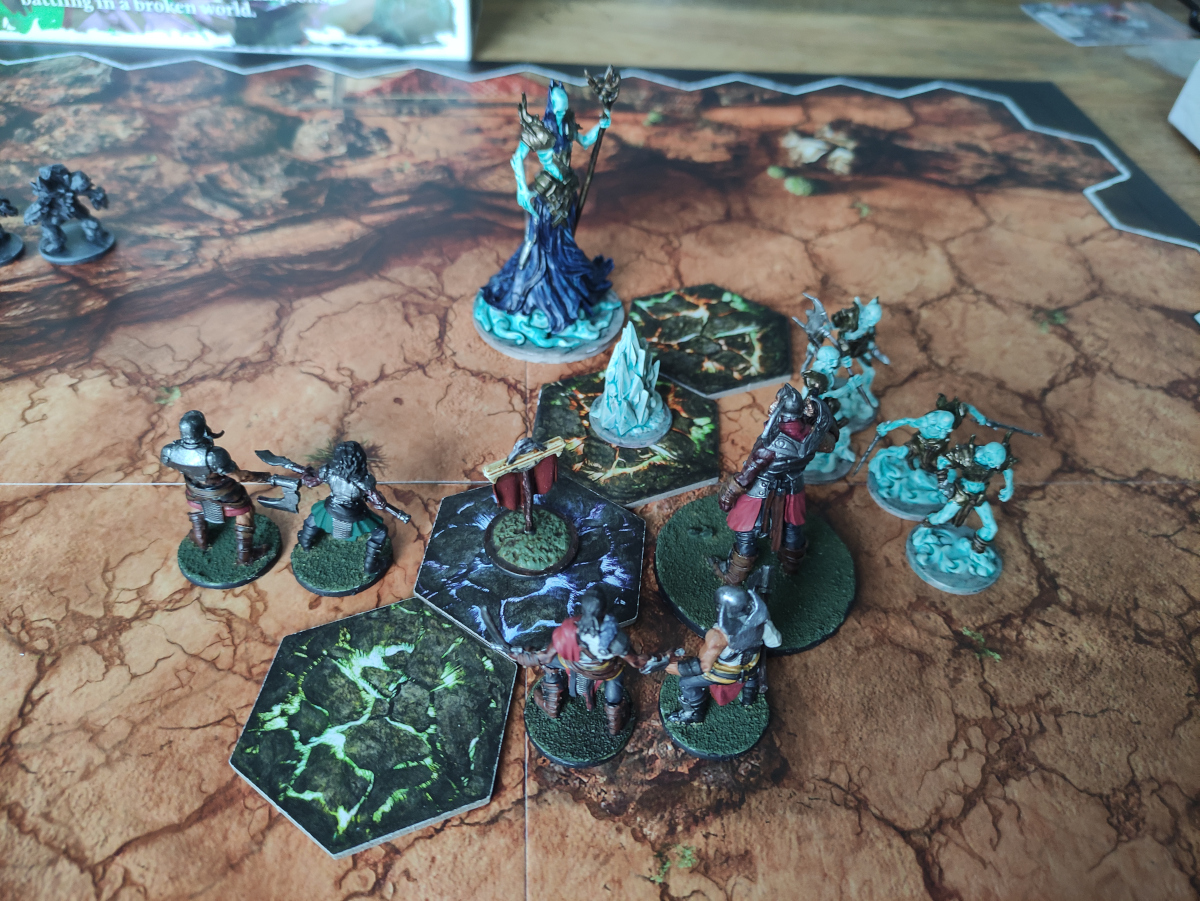
How Do You Play GodTear?
All the rules are available on the Steamforged Website, here. There’s even a quick start guide available. But here’s an overview of the rules.
Games take place over 1–5 rounds. During each round, a token is moved up and down a ladder that runs down one side of the board, between both players. The token starts off in the center of the board, though it is offset one space to the first player’s side. During a round, player actions can move the token closer towards them. In a round the token will move back and forth across the ladder. At the end of the round, the token will be on one player’s side. That player wins the round. They take the token and score the corresponding amount of victory points.
The token is reset and the next round begins. The player who lost the previous round gets to choose who goes first this time.
Rounds are scored, 1 Victory point for the 1st round, 2 for the 2nd, and 3 for the third. The 4th round scores 2 and the 5th only 1. As soon as somebody scores 5 Victory points the game is over. This makes winning round 3 very important!
How do fighters work?
Each warband has a class type. They don’t do a huge amount in game terms, but they do reflect the types of powers they might have and alter the tactics you would use in the game. GodTear has 4 class types. In a game where you are using 3 different warbands, you don’t have to use the same class types for each. In fact, it’s probably better to mix and match.
Each class type is defined by a different color on the box art and plastic used for the minis.
- Slayers – Red.
- Maelstroms – Yellow.
- Shapers – Green.
- Guardians – Blue.
Each warband is split into two components, a Champion and their Followers. Champions act independently of their followers. Followers are all activated together.
Warbands have 3 cards that are used to drive what they can do. One card is for Champion actions, one for Follower actions, and a third that details a Champion’s special ability and any other special rules that apply. The cards are double-sided and have different actions on them, depending on which side is face up. Cards start with the “plot phase” face showing.
How do you set up a game of GodTear?
Setup is simple. There are a number of different scenarios in the back of the rulebook but they work in essentially the same way.
- Place objective hexes. Each scenario has defined positions in which the objective hexes are placed. These are important because a) This is where you can place your banners to help move the token up the ladder on your side of the board and b) only Champions can enter objective hexes.
- Randomly choose who will go first.
- That person chooses a board edge to set up. Each scenario has a deployment map that shows you where you can set up your minis. This is generally straight along one edge.
- The score token is placed on the ladder. This starts in the center of the board, closest to the person who will start the game. If no points are scored at all this round (unlikely) the first player wins by default!
- Players deploy their fighters. Each player takes it in turns to deploy an entire warband, champions, and followers. All followers are deployed at the same time, but they don’t have to all be deployed in one place. They can go anywhere in the deployment zone. (Followers (mostly) act as one group in the game, even if they are spread out and they are often more powerful when used en masse.)
- Generally speaking, 1 Champion or up to 3 followers (from the same warband) can occupy a single hex.
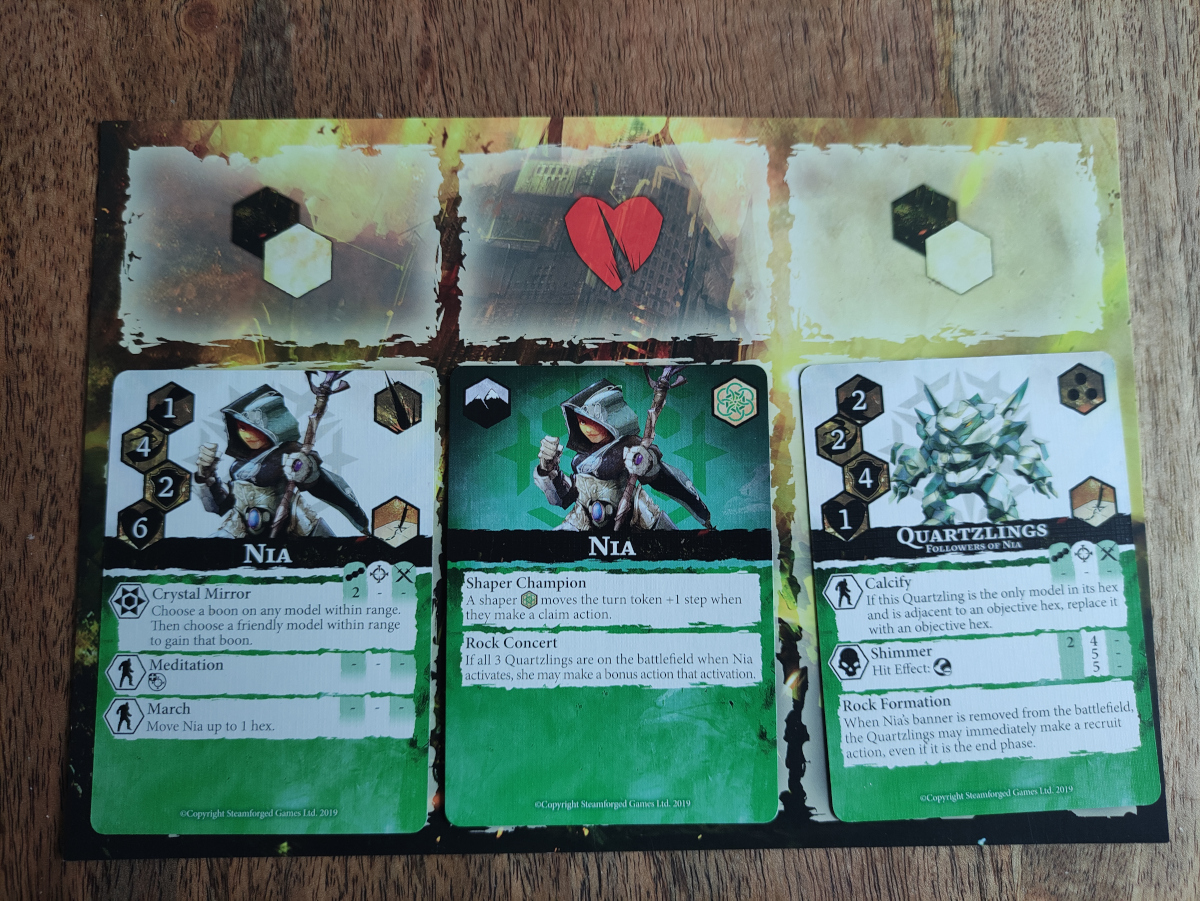
How does a GodTear turn work?
There is something very elegant about GodTear turns. For me, it’s what makes the game stand out. There are comparatively few choices each turn but each choice you make has tactical significance.
Turns are is broken down into two phases, the Plot Phase and the Clash Phase (The rules don’t say you HAVE to sing “London’s Calling” before starting the clash phase, but it’s very hard not to.)
During each phase, each unit (champion or follower) can be activated to perform 2 actions. Remember, each follower unit acts en masse, so each action performed will be carried out by all the members of the party. Having said that, when making an attack action, only a single hex is selected to attack from. Unless an ability specifically allows it, only the followers in one hex will make an attack action.
In the plot phase, the first player activates all their champions and followers before the second player activates theirs. It doesn’t matter which order you activate your models in, and there are many different reasons why you might activate some before others.
There are several types of action you can take. You can only take each specific action once per activation. You may only advance once, but you could choose to make two different skill actions.
- An advance action. This is essentially a move. The champion/followers move the distance given by their speed. Followers may not enter objective hexes, but champions can. Fighters cannot move through each other, friend or foe.
- A skill action. There are a number of different skill actions your champion and follower can make, as given on their card. Which one you choose will depend on your plan of action. During the plot phase, you are normally planning the best way to utilize your attacks in the clash phase.
- A Claim Action. This action is very important. A champion may claim an objective that they are adjacent to by placing a banner model on an objective hex. If a player can keep a banner in position until the end of the round it’s worth a big swing up the points ladder. The Claim action can only be made in the plot phase (THIS IS IMPORTANT!). Removing banners is done by walking over an opposing player’s banner. Remember, only champions can enter objectives so only champions can remove banners.
- A Rally Action. Champions are never killed, but if they do get knocked out (reduced to 0 hit points) they must take a Rally Action in order to get back into the fray.
- Recruit Action. This is similar to a Rally Action, but can only be made by followers. If some followers are out of action, a recruit action can bring one back to the board.
- Champions Special Action. This is (usually) a one-shot powerful action that can swing the game. Timing is everything for this one!
After your Champion/Follower has activated you flip their card over so they are ready for the Clash Phase.
Combat in a game of GodTear
Combat tends to happen in the Clash Phase. It’s on the clash phase side of a card that your champion/followers attack skill actions reside.
In contrast to the plot phase, players alternate turns to activate champions/followers in the clash phase. You can choose which order you activate your units in, but after you’ve activate a unit your opponent will get to activate one of theirs.
In the clash phase, you can still take advance actions to move into place but after that, it’s almost certainly going to be time to attack.
Attacks are skill actions on cards. Each attack has a range – a number of hexes they can reach and an accuracy stat, the number of dice they roll to hit.
For an attack to be successful players have to roll the same number or more successes on their dice than the opposing fighter’s dodge characteristic. If they do so, they can do damage; if not, the attack ends.
Some attacks have special effects; these are resolved after a successful hit and before damage is rolled.
The final stat of an attack is its damage. Again, this is the number of dice a fighter rolls to damage. The score rolled, minus the enemy fighter’s Protection score, is the amount of damage inflicted.
Generally, followers have only 1 wound, so a single point of damage will be enough to remove them from the board. If a Champion is reduced to zero hit points they are knocked out and will be forced to make a Rally action before doing anything else, when they next activate. The attacking player can also push the Champion 2 hexes in any direction. This small movement can really mess up your opponent’s plan and can mean the difference between defeat and victory!
Units can attack more than once if they have separate attacks actions on their cards, but they may not use the same action twice.

Blights and Boons.
GodTear has a neat mechanic for adding modifiers to rolls. Often in this type of game, all the cumulative buffs and debuffs to fighters get very confusing. It’s very easy to forget them and potentially inadvertently cheat (or, worst-case scenario, in a competitive setting, a player can deliberately forget a -ve effect and their opponent be none the wiser). GodTear’s Blight and Boon tokens are a breath of fresh air.
There are four tokens altogether: Move, Dodge, Accuracy, and Protection. They’re double-sided. One side is a boon, the other blight. Boons give +1 to the relevant stat and blights -1. Fighters can only have one of each of the 5 types of token on their card at any one time. A boon token given to a fighter that is carrying the corresponding blight token cancels that blight token out and the net effect is no token is placed on the fighter card. The boon and blight tokens are a simple mechanic that make it very easy to see what the game state is.
Warbands gain blights and boons through the interactions of the actions on their fighter cards. Generally things you do in the plot phase will buff your fighters or debuff your opponent’s.
How Do I Win?
During a GodTear turn, there is a token that moves up and down the side of the board. At the end of the turn that token will be closer to one player or the other. Whoever has the token closest to them wins the round and claims the token and the corresponding victory points. (Which across the 5 rounds goes 1, 2, 3, 2, 1 VPs). The first person to 5 victory points is the winner.
The key to winning a game of GodTear is pulling that victory token towards you. There are a number of ways you can do this.
- Knock out an enemy champion – 4 steps.
- Knock out a small enemy follower – 1 step.
- Knock out a large enemy follower – 2 steps. (I’ve yet to use a warband with large followers.)
- Make a claim action during the plot phase – 1 step.
- Have one of your banners on an objective hex during the end phase – 4 steps.
In addition to this, as described above, each warband will belong to one of of four classes. Depending on the given class, they will get a small boost for completing one of the above conditions. Classes give a general guide to what strategy you should be following and the focus of a given warband’s abilities.
The consistent but tiered way in which victory points are gained adds an interesting tactical focus to the game. You need to build your strategy to winning round 3, and if you can pick up round 2 on the way, so much the better!
One final point worth mentioning is that GodTear also contains several different scenarios that suggest different objective hex placement and some in-between round shenanigans. These don’t overload things with complexity but do allow players to keep things fresh and offer different tactical challenges during games.
Why Play GodTear?
For a tabletop arena combat game, GodTear is very streamlined. If you compare it with games like Aristeia! and Warhammer Underworlds it is very intuitive. The core rules are very simple, but because each warband only has 2 different parts and each turn consists of two discrete phases, you never feel overwhelmed with choices. It’s also very hard to forget an ability or a buff and debuff. Everything is there in front of you and there are few (if any) opportunities to react mid-turn, so the game state is never subject to breaks in the usual flow of the rules.
Once you’ve played a few times with a given warband, you can easily cement in your mind what it can do. The tricky bit is learning how best to utilize a warband’s abilities to come out victorious. Despite GodTear’s core simplicity, there are some difficult tactical decisions that have to be made in order to win the game. It’s the most chess-like experience I’ve had with a tabletop game. Yes, the pieces have some funny powers, but at the end of the day it’s often positioning and timing that will see you win the game.
I haven’t quite got my head around the probabilities of the game, which is probably the key to being consistently successful. You sling a lot of dice in games of GodTear but because they are low scoring dice, the game doesn’t feel swingy. There doesn’t seem to be a way in which a lucky roll on a single die can scupper a well-thought-out, powerful, attack. At the stage I’m at, it’s sling the dice and hope for the best!
I love that each warband is a discrete unit. There is no collectible element, other than the desire to buy the band itself. Often in these types of game you are forced to buy certain boxes to pick up specific cards to enhance your game. Here, whilst I’m sure certain warbands have advantages over others, you won’t feel forced to buy something just to optimize your strategy. You’ll buy it because you like the aesthetic or attractive mechanics.
It is a little bit frustrating that buying a core box doesn’t give you the full gaming experience and this is something to be aware of if jumping into this game for the first time. Having said that, the business model for this type of game is that more stuff than what’s in the core box is needed to enhance your games. More warbands = more combinations = more fun (hopefully). I will stress however that beyond learning the mechanics of the game, games with only 1 (or even 2) warbands per player won’t show the best GodTear has to offer. You really do want to be playing 3 warbands a side. At that point the mechanics, tactics, and gameplay shine.
The release timing for GodTear could not have been worse. It is a tournament competitive game, and its first full season should have been in full swing right as COVID-19 started ripping across the planet. The game does have some dedicated fans, but, right now, it’s not as huge as it deserves to be.
There are 16 warbands to choose from at the moment (I think), in addition to the four that come in the two core boxes. 4 warbands for each of the game’s warband classes. I don’t think you’ll be buying GodTear just for its models though. This is one area where Warhammer Underworlds does have it beaten. Steamforged Models are not the quality of Games Workshop’s. The sculpting isn’t as good and the plastic is much softer and less defined.
Painting the GodTear models was a frustrating experience. I think you may well be better picking a base color and use drybrushing and a wash to pick out detail. That said, no assembly is required. There are definitely advantages to being able to play straight out of the box without reaching for cutters and instructions.
I’ve ranked GodTear as “GeekDad Approved” as it offers a great tactical experience for a comparatively small price. It’s simple to pick up but challenging to master, the sign of a well-designed game. Whilst you do have to extend your purchases to play the full game, Steamforged business model doesn’t force you buy everything to stay competitive. With some inventive mechanics and great in-game interactions, GodTear is an excellent addition to the arena combat arena!
![]() To subscribe to GeekDad’s tabletop gaming coverage, please copy this link and add it to your RSS reader.
To subscribe to GeekDad’s tabletop gaming coverage, please copy this link and add it to your RSS reader.
Click here to see all our tabletop game reviews.
Disclosure: GeekDad received a copy of this game for review purposes.
